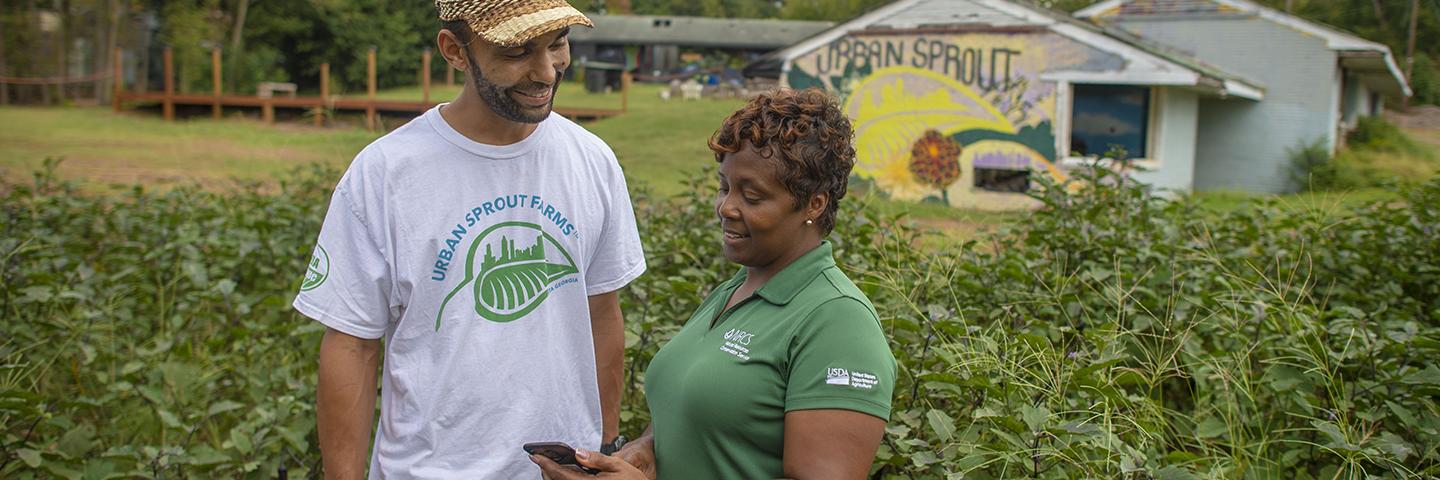
Press Release

Are you farming or gardening in a city or suburb? Urban agriculture provides critical access to healthy food for local communities, as well as jobs, increased green spaces, and closer community ties.
Urban agriculture includes the cultivation, processing, and distribution of agricultural products in urban and suburban areas. Community gardens, rooftop farms, hydroponic, aeroponic and aquaponic facilities, and vertical production, are all examples of urban agriculture. Tribal communities and small towns may also be included.
NRCS offers technical and financial assistance with conservation practices, including:
Through free technical assistance, NRCS can help you identify your goals and develop a conservation plan.
Contact the NRCS at your local Service Center to learn more. If you need information in a language other than English, we offer free translation services at our Service Centers.
Watch an overview of how NRCS is helping urban farmers.
See what urban farmers in Dallas, Texas are doing and how NRCS is helping.
In addition to NRCS, other USDA agencies, including the Farm Service Agency (FSA), Risk Management Agency, and Agricultural Marketing Service (AMS), offer programs and services to urban producers. To learn more:
NRCS also leads USDA’s Office of Urban Agriculture and Innovative Production (OUAIP), scaling up support for urban farmers across the country. OUAIP invests in grants supporting urban agriculture and innovation production. OUAIP also awards cooperative agreements that support composting and reduce food waste. OUAIP also coordinates with a Federal Advisory Committee, which provides recommendations to the USDA Secretary, as well as FSA county committees that focus on urban and suburban areas.
USDA renewed the People’s Garden movement in 2022 to:
These gardens incorporate sustainable practices, many of which are rooted in conservation practices that NRCS helps farmers and ranchers with across the country. For example, read more on soil health and the importance of pollinators.
Do you farm or ranch and want to make improvements to the land that you own or lease?
Natural Resources Conservation Service offers technical and financial assistance to help farmers, ranchers and forest landowners.

To get started with NRCS, we recommend you stop by your local NRCS field office. We’ll discuss your vision for your land.
NRCS provides landowners with free technical assistance, or advice, for their land. Common technical assistance includes: resource assessment, practice design and resource monitoring. Your conservation planner will help you determine if financial assistance is right for you.
We’ll walk you through the application process. To get started on applying for financial assistance, we’ll work with you:
Once complete, we’ll work with you on the application, or CPA 1200.
Applications for most programs are accepted on a continuous basis, but they’re considered for funding in different ranking periods. Be sure to ask your local NRCS district conservationist about the deadline for the ranking period to ensure you turn in your application in time.
As part of the application process, we’ll check to see if you are eligible. To do this, you’ll need to bring:
If you don’t have a farm number, you can get one from USDA’s Farm Service Agency. Typically, the local FSA office is located in the same building as the local NRCS office. You only need a farm number if you’re interested in financial assistance.
NRCS will take a look at the applications and rank them according to local resource concerns, the amount of conservation benefits the work will provide and the needs of applicants. View Application Ranking Dates by State.
If you’re selected, you can choose whether to sign the contract for the work to be done.
Once you sign the contract, you’ll be provided standards and specifications for completing the practice or practices, and then you will have a specified amount of time to implement. Once the work is implemented and inspected, you’ll be paid the rate of compensation for the work if it meets NRCS standards and specifications.